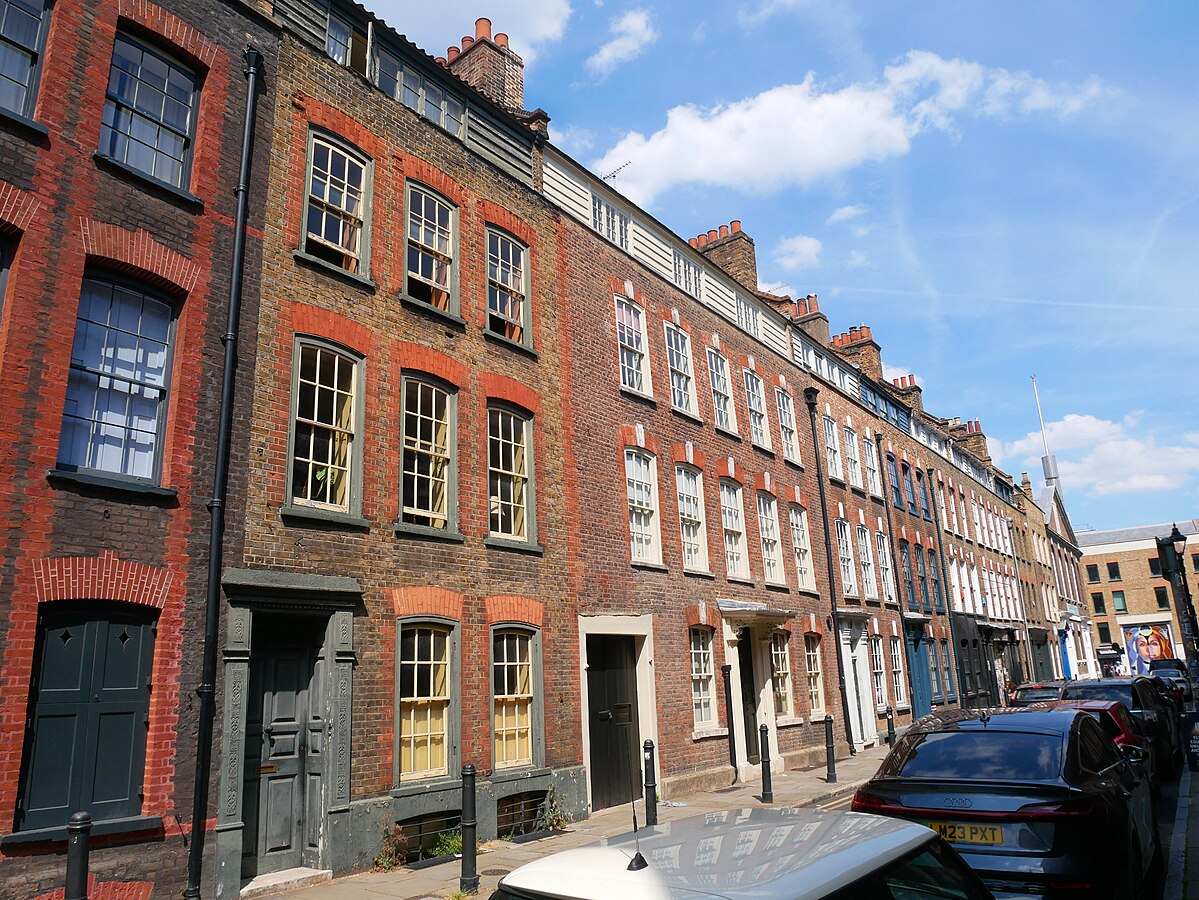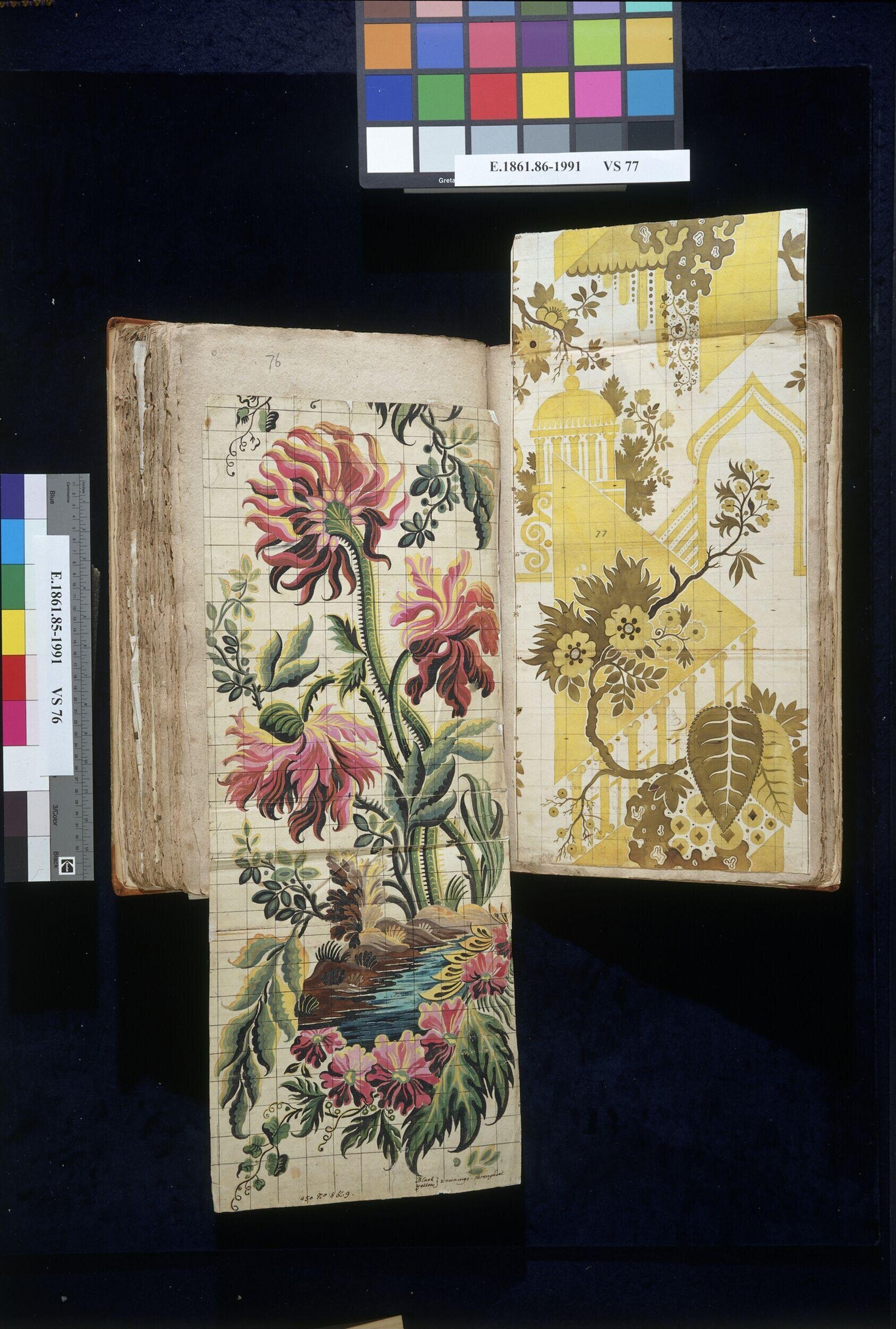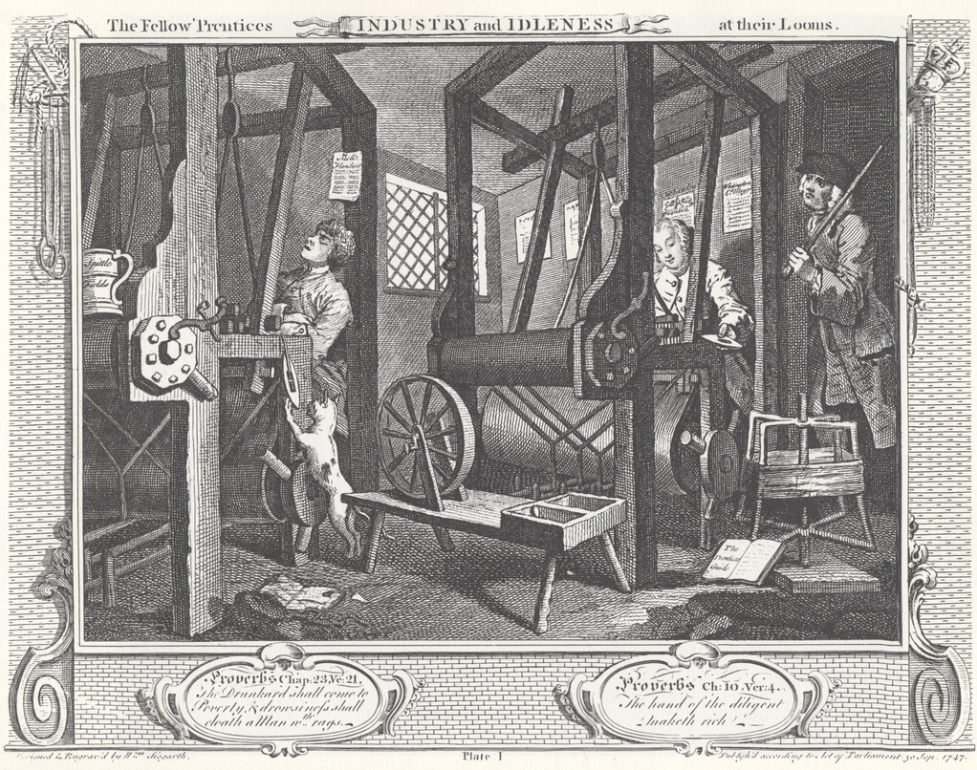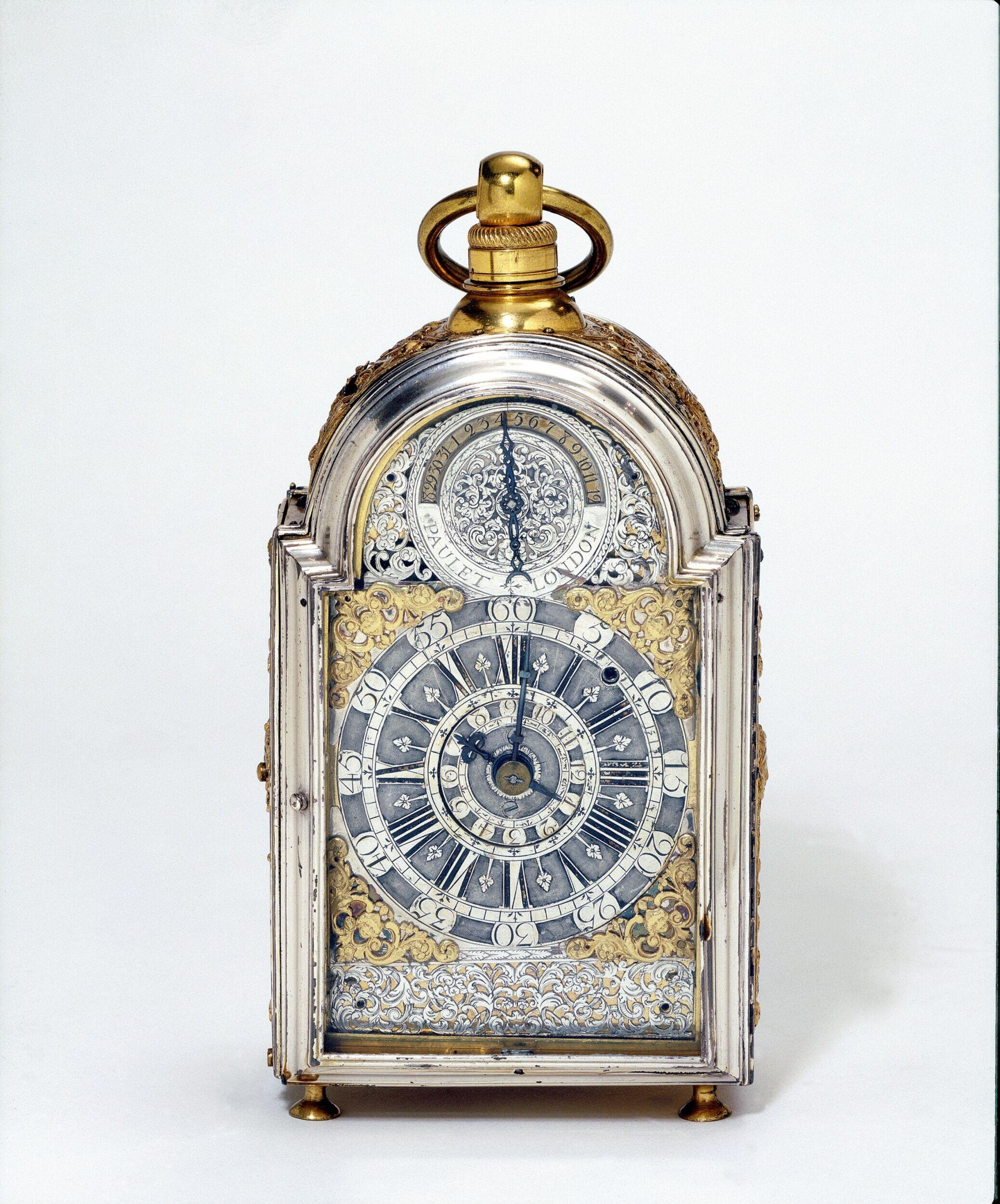Posted by e.m.vine@exeter.ac.uk
26 August 2025This month’s post explores the will of Daniel Godfroy, a Huguenot and ‘Master Weaver of Stepney’, who died in 1726 and whose will was ‘Translated from the French’.[1] Stepney, an ancient parish which included the Spitalfields area, was the heart of the London Huguenot community in the early eighteenth century: indeed some Londoners ‘complained that French was the only language they heard in the area’.[2] Godfroy’s will provides a snapshot of the workings of this large but also tight-knit community: it includes money left to the local French church and congregational charities, references to the characteristically Huguenot trades of silk-weaving, silversmithing, and clock-making, and bequests given mainly to people with identifiably French names.

Money to ‘the ffrench Church’
Most of Stepney’s Huguenots arrived in the late seventeenth century, following the revocation of the Edict of Nantes in 1685, which forced thousands of Protestants to flee France as refugees. It has been suggested that by 1700, around 5% of London’s population of 575,000 was Huguenot, and there were nine French places of worship in Spitalfields alone.[3] Twenty-five years later, the continued strength of the community in this area is tangible through the people and institutions that Godfroy mentioned in his will.
Godfroy, a ‘Master Weaver’, would have been a wealthy businessman who employed others in the weaving trade, and who may have lived in a large townhouse like those on Fournier Street in Spitalfields (above). He left ‘to the Elders and Deacons of the ffrench Church in threedneedle Street London the Sume of ten pounds Sterling for the use of the poor’.[4] Donating to the poor of a particular congregation, who would have been first- or second-generation refugees, is linked to the tradition of providing for the poor of the testator’s local parish. The Threadneedle Street church, in the City of London, was the first French church to be established in London. It followed a French Calvinist liturgy, as opposed to the other large French church at the Savoy, in London’s West End, which used a French translation of the English liturgy.[5] In the 1680s, the Threadneedle Street church had faced increasing pressure to conform to the Church of England, but this eased following fears that the local wealthy Huguenot merchants and craftsmen would move from the area.[6]

Design for woven silk from the ‘Leman Album’, pencil, pen and ink, watercolour and bodycolour on laid paper, possibly by James Leman, 1734. James Leman was a second-generation Huguenot refugee, and silk weaver and designer who was living and working in Spitalfields at the same time as Godfroy. https://collections.vam.ac.uk/item/O65210/design-leman-james/ © Victoria and Albert Museum, London, 2025
Godfroy also bequeathed ‘ffifty pounds to the Deacons of the said ffrench Church in threed needle Street London towards the maintaining of the School of their hospital in Spittlesfields’. The charity school educated children up until the age of fourteen, at which point they would be apprenticed to local craftsmen, like the ‘Master Weaver’ testator himself.[7] Godfroy’s charitable bequests made provisions for the maintenance and future of the east London Huguenot community and its signature trades.
The tools ‘belonging to a Weavers’ Trade’
Huguenot silk-weavers moved to Stepney in large numbers, while those associated with the clock-making and silversmithing trades tended to live and set up shop in Soho.[8] Godfroy’s will provides evidence of his connections with the weavers he lived and worked alongside. He named as one of the executors of the will of ‘Mathew Benoist master Weaver living at the Artillery’. The Artillery Lane area of Spitalfields had a large French population and was also the location of the Huguenot soup kitchen, an area, like many pockets of London, where rich and poor lived alongside each other.[9]

The Master Weaver is pictured on the extreme right of this engraving by William Hogarth – Industry and Idleness, Plate 1; The Fellow ‘Prentices at their Looms (1747) https://commons.wikimedia.org/wiki/File:William_Hogarth_-_Industry_and_Idleness,_Plate_1;_The_Fellow_%27Prentices_at_their_Looms.png#/media/File:William_Hogarth_-_Industry_and_Idleness,_Plate_1;_The_Fellow_’Prentices_at_their_Looms.png –
Godfroy left to his stepson ‘all the Loomes and Harnesses belonging to a Weavers’ Trade together with the Scales and weights a great and a Smal press [perhaps a clothes press or cupboard] a great Trunk’. As a ‘Master Weaver’ who presumably took pride in his work, there was perhaps sentimentality as well as practicality in bequeathing the tools of his trade. References to occupational identities appear frequently in the wills that our project examines, and indeed, in a previous post, we discussed the professional pride of a Gloucester capmaker who left a fellow capmaker ‘the beste cappe of my makyng’. For Huguenots, so closely associated with particular occupations, the relationship between trade, craftsmanship, and community identity was perhaps even more closely interlinked.
In a similar manner to his donation to the French school, Godfroy’s bequest of the tools of his trade both provided a living for a younger family member and also secured the future of a skilled craft. He also discussed another young stepson, John Amery, who he had ‘put to a Trade’, and affirmed ‘I have promised to Clothe him during his apprenticeship’. Perhaps it is unsurprising that clothes played a prominent role in this silk-weaver’s will. Godfroy did not only provide money for his stepson to be provided with clothes, but also directly left him ‘all my Clothes and Linnen for my use’.

Bracket Clock, Made in London, the movement signed ‘Paulet London’ (active about 1710). The distinctly Continental style of his clocks and his French name suggest that he was a Huguenot. https://collections.vam.ac.uk/item/O77617/bracket-clock-paulet/ © Victoria and Albert Museum, London, 2025
The object and its maker
Godfroy’s will also mentioned other objects associated with Huguenot craftsmanship, namely the trades of silversmithing and clock- or watchmaking. His stepson Samuel Picard received ‘a Silver Tankard which had been bought by my Wife his Mother’, while Samuel’s brother Isaac received ‘my Silver Watch and a Clock of Robins’ making’. This refers to a particular named craftsman, possibly a relative of Robert Robin, a later Parisian clockmaker who worked and found fame in the later eighteenth century. In any case, the name of the maker carried value in Godfroy’s mind, and he was keen to set down its provenance in writing.
Godfroy made his will around forty years after the main wave of Huguenot migration to east London. Judging by his professional seniority, and the fact that he had been married twice with several stepchildren, we can infer that he was an older man, and probably a first-generation émigré. This would explain why his will was written in French, and why both its witnesses and the Notary Public who drafted it, Isaac Delpeech or Delpech, were also Huguenot. His will provides evidence of a refugee who had arrived in London and reached the top of his craft, and indeed had been among the generation that had established Spitalfields as the centre of silk-weaving in the face of some early hostility from English weavers.[10] Godfroy was wealthy, he employed others, and he left money for the poor of the French community and to ensure the future of its people and its trades. Aside from monetary bequests, most of the objects mentioned were associated with characteristic Huguenot industries: the weaver’s loom, harnesses, scales, weights, and other tools, a silver tankard, a silver watch, and a clock made by an esteemed maker. While many wills discussed objects that had sentimental value, or left work tools to children or young people, it is striking to read a document where community, identity, and craftsmanship are so closely intertwined.
Full transcription of the Will of Daniel Godfroy, Master Weaver of Stepney , Middlesex, 08 March 1726, PROB 11/608/48
Translated from the French
In the Name of God Amen
I Daniel Godfroy master Weaver living in the parish of
Stepney in the County of Middlesex being by the Grace of
God of Sound body and mind make my Testament in the
manner following Imprimis I recommend my Soul to God in the
name and by the merits of my Saviour Jesus Christ leaving my
body to the Earth in hopes of a happy Resurrection and as concerning
my temporal goods I dispose thereof as follows I give and bequeath
to Samuel Picard son of my first wife the sume of four hundred
pounds Sterling which shall be deducted out of what he shall owe
me at the time of my decease and if there should be found less the
Surplus of the present Legacy shall be paid him by my Executors
within Six months after my decease and I give him further all the
Loomes and Harnesses belonging to a Weavers’ Trade together
with the Scales and weights a great and a Smal press a great
Trunk and a Silver Tankard which had been bought by my Wife his
Mother and besides that I give him ten pounds Sterling for mourning
and in Consideration of the Legacy hereabove the said Samuel Pikard
shall not demand any thing upon my goods either on account of his
Mothers Estate or what be longed to late Leonard Picard his ffather
Item I give to Isaac Picard another son of the said Leonard my
Silver Watch and a Clock of Robins’ making and ten pounds Sterling
for mourning Item I bequeath to the said Samuel Picard the sume
of four hundred pounds Sterling whereof he shall pay himself out of what
he owes me at the time of my decease and if he owes me less my Executors
shall pay him upon the aforesaid delay of six months next after my
decease the Surplus of the present Legacy and my Will is that the said
Samuel Picard shall possess the said Sume of four hundred pounds Sterling
last mentioned in Trust for the uses following viztt that he shall pay
the Interest thereof at five per Cent per annum to his said brother
Isaac Picart for his life unless the said Samuel should think proper
to pay to the said Isaac in his life time the whole or part thereof
which I leave absolutely in the power of the said Samuel without the
said Isaacs constraining him in any manner and if at the decease
[new page]
of the said Isaac he leaves one or more Children and that the said
Samuel had in his possession the said sume of four hundred pounds
Sterling or any part thereof it shall go to the said Child or Children to
whom the said Samuel shall deliver the same to at his Majority and
shall imploy in the mean time the Interest for the use of the said Child
or Children and in Consideration of the said Legacy the said Isaac
Picart shall not demand any thing upon my goods of the portion of his
said ffather nor of that of his said Mother and if the said Isaac leaves
no Children and that his Children dye before they be of age what shall be
found remaining of the present Legacy in the hands of the said Samuel
Picart shall belong to him the said Samuel Picart or to his Children –
and whereas I have put to a Trade John Amery son of my deceased last
Wife to Peter Courtois and that I have signed a Writing by which
I have promised to Clothe him during his apprenticeship and I left
it in the power of my said Wife his mother if she had survived me
to give him one hundred pounds Sterling at the Expiration of his
apprenticeship I will and order that the said Sume of one hundred
pounds Sterling be paid to the said John Amory at the end of his
apprenticeship and that the Interest thereof be in the mean while
imployed for his Clothing unless I have paid the same in my life time
Item I bequeath to my Mother in law the Widow Ramet the sume of ffifty
pounds Sterling for her and her Children and her Receipt will be a good
and Sufficient discharge for my Executors who shall pay it her Six months
after my decease Item I bequeath to the Elders and Deacons of the
ffrench Church in threed needle Street London the Sume of ten pounds
Sterling for the use of the poor imediately after my decease I nominate
and constitute my good friends John Ramet my brother in law and
Mathew Benoist master Weaver living at the Artillery Executors of my
present Testament desireing them to take Care thereof and to accept the
Legacy that I make them of ten pounds Sterling each and as concerning
all the rest and residue of the goods Effects and other things which
shall be found belonging to me at my decease I give and bequeath
them to my dear and only daughter Mary Godfroy and as she is
about six years of age only I will that my Executors put out what I shall
leave her upon publick ffunds and employ the Interest or what shall be
necessary for the board bringing up and Education of my said Daughter
untill the delivery of the Capitall which deliverance of the said Capital
and of what shall remain of the Interest they shall belong to my said
Daughter when she shall be of age or when she shall be married
upon Condition that she marries with the Consent of her Grand mother
and of my Executors or any of them and in Case that my said Daughter
dyes before her being of age or marriage my Will is that upon
what I leave her there shall go and appertain to the said Widow
Ramet my mother in law one hundred pounds Sterling and ffifty
pounds to the Deacons of the said ffrench Church in threed needle
Street London towards the maintaining of the School of their hospital
in Spittlefields and the Surplus of the said residue in Case of the death
of my said Daughter shall be divided in three equall portions between
the said Samuel Picart Isaac Picard and John Amory I discharge my
said Executors of all unvoluntaryly Losses and will that they reimburse
themselves of all Losses that they shall be at concerning the Execution
of my present Testament and I desire them to deliver imediately after
[new page]
[illeg] Twenty third day of July in the year of our Lord one Thousand Seven Hundred and fforty three Adon (with the Will annexed of the Goods Chatells and Credits of
Daniel Godfrey late of the Parish of Stepney in the County of Midx deced left unadministred by John Ramett and Mathew Benoist the Executors named in the
aaid Will now also respectively deced was granted to Mary Godfrey Spinster the natural and lawfull Daughter of the said Deced and Residuary Legatee named
in the said Will being first sworn duly to adster Letters of Acon with the Will annexed of the said Deced granted in December 1739 to James Ramett As Guardian
to the said Mary Godfrey then a Minor and for her use and benefit and untill she should attain the age of Twenty one Years being ceased and expired
my decease all my Clothes and Linnen for my use to the said John
Amory Son of my said deceased Wife I make void revoke and annull
all Testaments and preceding dispositions and will that the present
be and avail as my last Testament In witness whereof I have
signed and Sealed my said present Testament at London the eighth
day of December in the year of Grace one thousand seven hundred
and twenty five. Daniel Godfrey (LS) Signed Sealed pronounced
and declared by the said Daniel Godfrey for to be his Testament and
last Will in the presence of us who have signed in the presence and at
the request of the said Testator Samuel Labouneistre Dav. Jo. Delpeech
Isaac Delpeech Not. Publ. 1725. Substantialiter Translatum p. Pet
St Eloy N. O.
On the Seventh Day of December
In the year of our Lord 1739
Power was granted to James Ramett
The Guardian lawfully assigned to
Mary Godfroy a Minor on this Day
and residuary Legatees named in
the last Will and Testament of the said
Daniel Godfroy otherwise Godfrey
deced to cover the Goods Chattels
and Credits of the said deced
according to the tenor of his sd
Will left made by John
Ramett and Matthew Bonoist
the Extors named in the sd will
now also deced for the use &
benefit of the Minor and
until she attains the age of
21 years being sworn duly
to do. TW
[1] TNA PROB 11/608/48, Will of Daniel Godfroy, Master Weaver of Stepney , Middlesex, 8 March 1726.
[2] https://www.londonmuseum.org.uk/collections/london-stories/the-huguenots-london/
[3] Robin Gwynn, ‘The number of Huguenot immigrants in England in the late seventeenth century’, Journal of Historical Geography 9, (1983), pp.392–393; https://www.londonmuseum.org.uk/collections/london-stories/the-huguenots-london/
[4] TNA PROB 11/608/48, Will of Daniel Godfroy, Master Weaver of Stepney, Middlesex, 8 March 1726.
[5] G.C. Gibbs, ‘The Reception of the Huguenots in England and the Dutch Republic, 1680–1690’, in Ole Peter Grell, Jonathan I. Israel, and Nicholas Tyacke eds., From Persecution to Toleration: The Glorious Revolution and Religion in England (Oxford: OUP, 1991) pp.278-9; https://www.oldbaileyonline.org/about/huguenot
[6] John Hintermeier, ‘The First Modern Refugees? Charity, Entitlement, and Persuasion in the Huguenot Immigration of the 1680s’, Albion 32 (2002), p.445.
[7] https://www.huguenotsociety.org.uk/blog/blog
[8] https://www.londonmuseum.org.uk/collections/london-stories/the-huguenots-london/
[9] https://www.huguenotsociety.org.uk/blog/blog
[10] https://www.ourmigrationstory.org.uk/oms/huguenot-silk-weavers-in-spitalfields